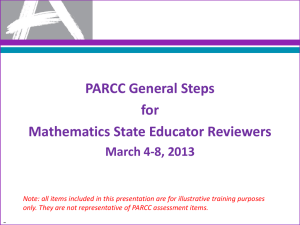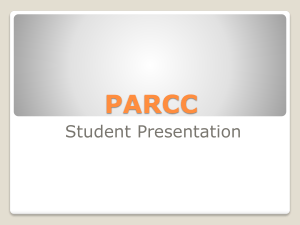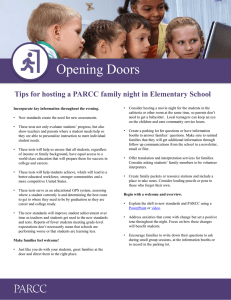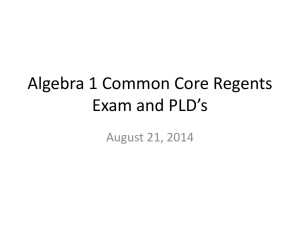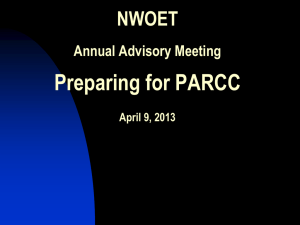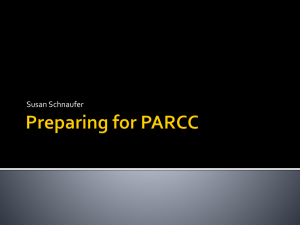PARCC Mathematics CLG Training (PPT)
advertisement
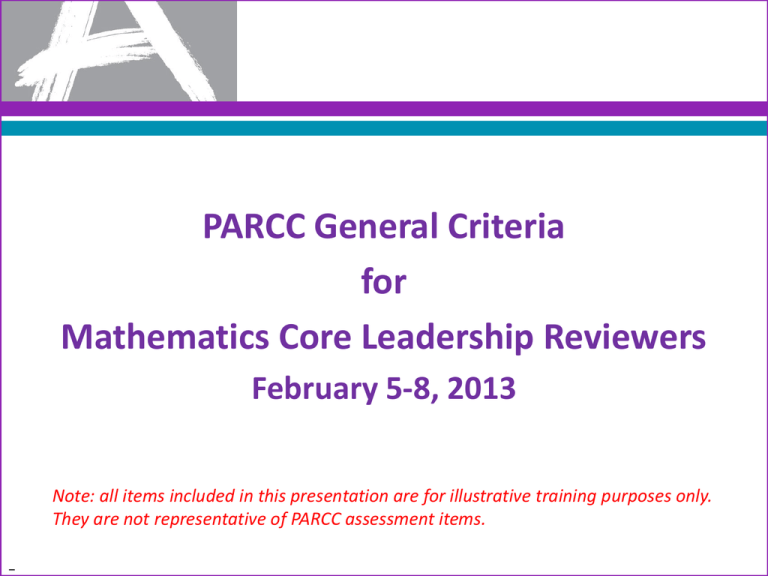
PARCC General Criteria for Mathematics Core Leadership Reviewers February 5-8, 2013 Note: all items included in this presentation are for illustrative training purposes only. They are not representative of PARCC assessment items. 1 Question 1 2 Does the task measure the intended evidence statement? Alignment to Evidence Statements and the CCSS Each task should: • assess the designated evidence statement • align with one or more of the Common Core State Standards associated with the evidence statement • align with one or more of the Mathematical Practices associated with the evidence statement • conform to the content clarifications, limits, and emphasis associated with the evidence statement • elicit student performance that will provide evidence of the student’s level of mastery of the mathematical standard(s) and practice(s) associated with the evidence statement • not be so broad in scope that it assesses multiple evidence statements 3 Sample #1a Task Type: I Points: 1 Evidence Statement: 3.NF.2 3 4 Jonathan’s teacher wrote two fractions, and , 10 5 on the board. Select four fractions that would lay, on a number line, between the two fractions Jonathan’s teacher wrote. 4 4 A) 13 3 C) 6 5 E) 3 2 B) 9 18 D) 30 29 F) 100 4 G) 5 Note: all items included in this presentation are for illustrative training purposes only. They are not representative of PARCC assessment items. Evidence Statement Text, Clarifications, Limits, Emphases and Other Information for 3.NF.2 5 Evidence Statement Text Understand a fraction as a number on the number line; represent fractions on a number line diagram. a. Represent a fraction 1/b on a number line diagram by defining the interval from 0 to 1 as the whole and partitioning it into b equal parts. Recognize that each part has size 1/b and that the endpoint of the part based at 0 locates the number 1/b on the number line. b. Represent a fraction a/b on a number line diagram by marking off a lengths 1/b from 0. Recognize that the resulting interval has size a/b and that its endpoint locates the number a/b on the number line. Clarifications, Limits, Emphases, and Other Information i) Fractions are not limited to values between 0 and 1. ii) Fractions equal whole numbers in 20% of these tasks. iii) Tasks have “thin context” or no context. . iv) Tasks are limited to fractions with denominators 2, 3, 4, 6, and 8. (See footnote CCSSM, p 24) Sample #1b Task Type: I Points: 1 Evidence Statement: 8.EE.2 Which values represent solutions to the equation 2x2 = 64? Select all that apply. 6 A) x = -16 D) x= 4 2 B) x = - 32 E) x = 32 C) x=-4 2 F) x = 16 Note: all items included in this presentation are for illustrative training purposes only. They are not representative of PARCC assessment items. Evidence Statement Text, Clarifications, Limits, Emphases and Other Information for 8.EE.2 7 Evidence Statement Text Use square root and cube root symbols to represent solutions to equations of the form x2 = p and x3 = p, where p is a positive rational number. Evaluate square roots of small perfect squares and cube roots of small perfect cubes. Know that 2 is irrational. Clarifications, Limits, Emphases, and Other Information i) Pool should contain tasks with and without contexts. ii) Tasks might for example take the form of algebraic word problems leading to equations x2 = p or x3 = p, or geometric problems such as finding the edge length of a cubical object with a given volume. iii) In problems where p and – p are both relevant as solutions to x2 = p, both of these solutions should be given. Note that p is nonnegative by definition. iii) Solutions to equations x2 = p or x3 = p are represented as p or 3 p , respectively. iv) Manipulations such as 8 = 2 2 are beyond the scope of grade 8. Students need not simplify a solution such as 8 . But students should ultimately express the following cases in the form of whole numbers: (a) the square roots of 1, 4, 9, 16, 25, 36, 49, 64, 81 and 100; (2) the cube roots of 1, 8, 27, and 64. Question 2 8 Is the task mathematically correct and free from errors? Mathematical Accuracy Each task should: • contain content (text, stimuli, terminology, notation, art, etc.) that is mathematically correct, precise, and generally accepted by math educators • not contain unintended mathematical errors, misconceptions, contradictions, or ambiguities 9 Sample #2 Task Type: I Points: 1 Evidence Statement: 6.G.1 This regular hexagon has been divided into congruent triangles. 12 in. 10 in. What is the area of the hexagon? square inches 10 Note: all items included in this presentation are for illustrative training purposes only. They are not representative of PARCC assessment items. Evidence Statement Text, Clarifications, Limits, Emphases and Other Information for 6.G.1 Evidence Statement Text Find the area of right triangles, other triangles, special quadrilaterals, and polygons by composing into rectangles or decomposing into triangles and other shapes; apply these techniques in the context of solving real-world and mathematical problems. Clarifications, Limits, Emphases, and Other Information i) 11 The testing interface can provide students with a calculation aid of the specified kind for these tasks Question 3 12 Is the task (wording and art) clear, cohesive, concise, accurate, grade-level appropriate, and free from internal clueing? Language Clarity and Appropriateness Each task should: • convey a clearly defined task or problem in concise and direct language • use the language of the evidence statements and standards when appropriate • exclude information that is construct irrelevant (e.g., sports knowledge that is needed to answer the question but is not provided) • use a variety of approaches rather than a canned approach 13 Sample #3 Task Type: I Points: 1 Evidence Statement: 7.NS.2b-2 3 1 3 ¸ Which situation can be represented by the expression ? 4 3 1 A) The width of a nightstand is the width of a dresser. If the width of 3 3 the dresser is 3 feet, what is the width of the nightstand? 3 4 B) There are 3 cups of flour in a container. How much flour is left in the 4 1 container after a baker takes cup of flour from it? 3 3 C) A relay race is 3 miles long. This distance is divided into equal parts 4 1 that are mile each. How many parts are there in the race? 3 1 D) A puppy’s weight increased by pound. What is the puppy’s new 3 3 weight if its original weight was 3 pounds? 4 14 Note: all items included in this presentation are for illustrative training purposes only. They are not representative of PARCC assessment items. Evidence Statement Text, Clarifications, Limits, Emphases and Other Information for 7.NS.2b-2 Evidence Statement Text Apply and extend previous understandings of multiplication and division and of fractions to multiply and divide rational numbers. c. Interpret quotients of rational numbers by describing real-world contexts. Clarifications, Limits, Emphases, and Other Information 15 – Question 4 16 If technology is involved in the task, is it used effectively? Effectiveness and Grade Appropriateness of Technology Each task should: • include the number of options and correct answers that are appropriate for the grade level • use a format that is sufficiently simple yet interesting and engaging for students • include directions that are clear and detailed 17 Sample #4 Task Type: I Points: 1 Evidence Statement: N-CN.2 As part of a mathematics homework assignment for practicing FOILing with complex numbers, a student needs to simplify the expression (3 + 4i)(5 + 2i). The homework assignment is due tomorrow at the beginning of math class. What should the student write for the simplified form of (3 + 4i)(5 + 2i) to receive full credit for the answer to the mathematics homework assignment for practicing FOILing with complex numbers? Select the simplified expression. 7 + 26i 18 15 + 34i 15 + 8i 23 + 26i Note: all items included in this presentation are for illustrative training purposes only. They are not representative of PARCC assessment items. Evidence Statement Text, Clarifications, Limits, Emphases and Other Information for N-CN.2 Evidence Statement Text Clarifications, Limits, Emphases, and Other Information 19 Use the relation i2 = –1 and the commutative, associative, and distributive properties to add, subtract, and multiply complex numbers. – Question 5 20 For Type II and Type III tasks, is the scoring guide/rubric clear, correct, and aligned with the expectations for performance that are expressed in the task? Scoring Rubrics Scoring Rubrics should: • be clear enough so that the person scoring the response will know how to assign points based on different parts of the response • assign more of the points to the explanation (reasoning/modeling) provided in the response and less of the points to a correct response 21 Sample #5 Task Type: II Points: 4 Evidence Statement: 5.C.6/5.MD.5c Rosa needs to calculate the volume of a right prism. This diagram shows the dimensions of the prism. All angles in the base of the prism are right angles. 5 in. 4 in. 7 in. 7 in. 6 in. 12 in. 11 in. Show how Rosa can calculate the volume of the right prism. Be sure to explain why you chose the operations you use in your calculation, and include the volume of the prism. 22 Note: all items included in this presentation are for illustrative training purposes only. They are not representative of PARCC assessment items. Evidence Statement Text, Clarifications, Limits, Emphases and Other Information for 5.C.6 and 5.MD.5c Evidence Statement Text Content Scope: Knowledge and skills articulated in 5.MD.C 5.C.6 Clarifications, Limits, Emphases, and Other Information Evidence Statement Text – Relate the operations of multiplication and addition and solve real world and mathematical problems involving volume. c. Recognize volume as additive. Find volumes of solid figures composed of two non-overlapping right rectangular prisms by adding the volumes of the non-overlapping parts, applying this technique to solve real world problems. 5.MD.5c Clarifications, Limits, Emphases, and Other Information 23 Base explanations/reasoning on concrete referents such as diagrams (whether provided in the prompt or constructed by the student in her response). i) Tasks require students to solve a contextual problem by applying the indicated concepts and skills. Scoring Rubric for Sample #5 Scoring Rubric The task is worth 4 points; 1 point for computation and 3 points for reasoning. Computation component: 582 cubic inches Reasoning component: 1 point is awarded for a correct process in which the student shows or explains how to divide the prism into two (or more) right rectangular prisms 1 point is awarded for showing or explaining the correct calculations for determining the volume of each rectangular prism 1 point is awarded for showing or explaining that the volumes need to be added together to determine the volume of the entire prism. 24 Questions?
